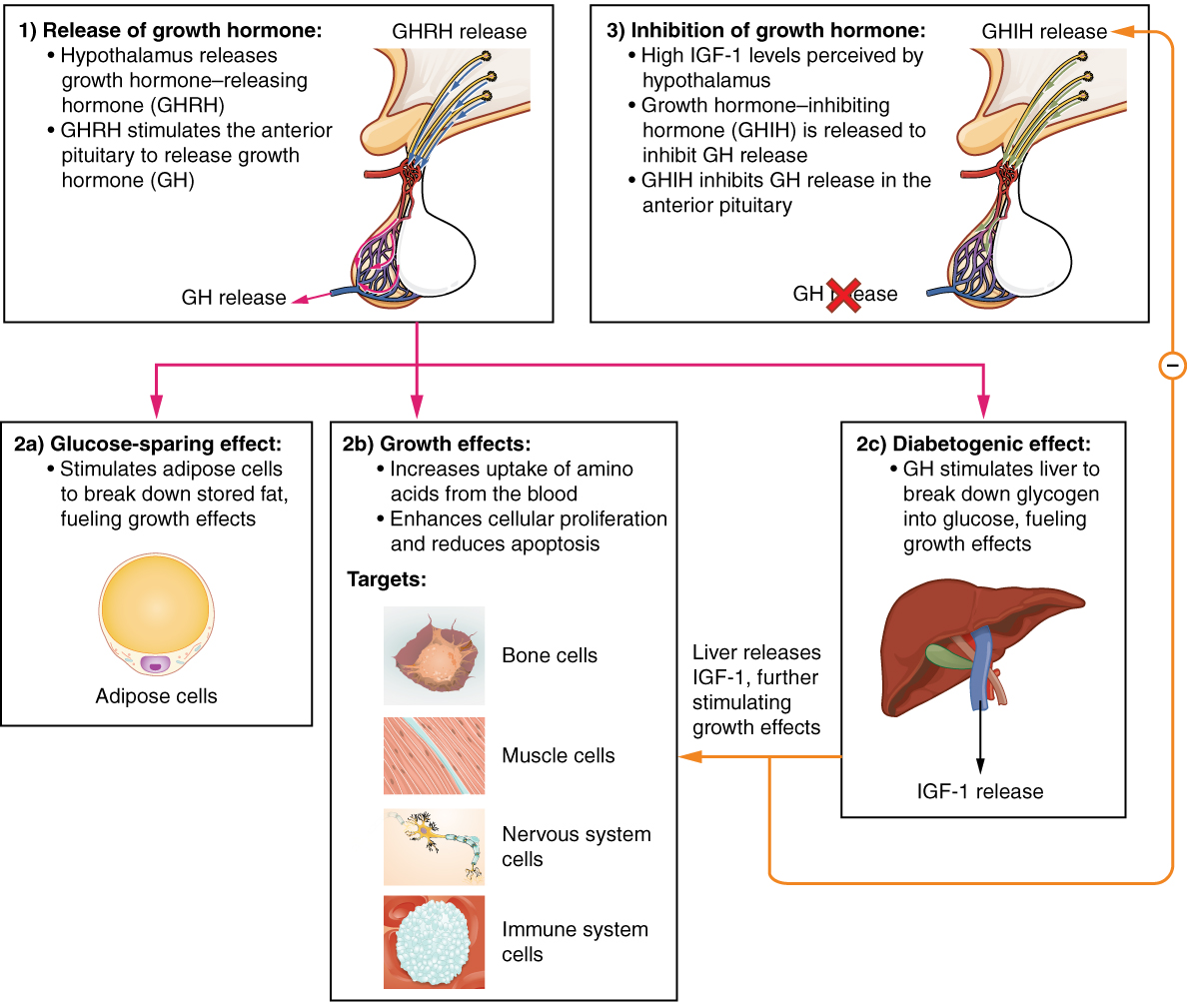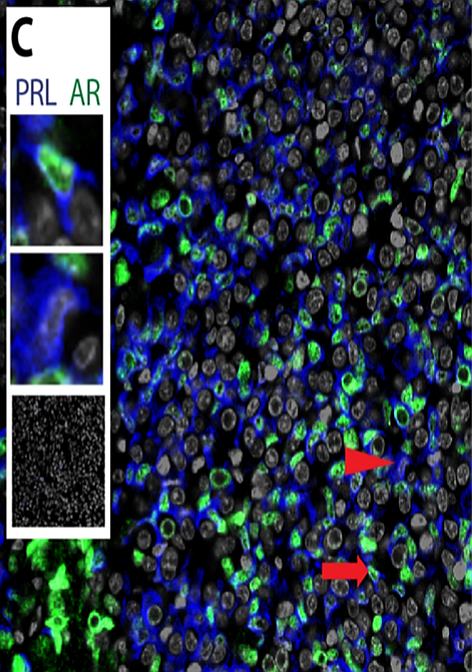|
PIT-1
POU class 1 homeobox 1, also known as pituitary-specific positive transcription factor 1 (PIT1), POU domain, class 1, transcription factor 1 (POU1F1) and growth hormone factor 1 (GHF1), is a transcription factor for growth hormone encoded by the gene ''POU1F1''. Function PIT1 is part of the POU family of transcription factors. It is expressed by somatotrophic cells, as well as thyrotrophs and lactotrophs of the anterior pituitary gland. It contains a C-terminal domain for transactivation. Another domain is DNA binding—its C-terminal portion is homologous to the homeodomain consensus, common to many genes involved in development, while the other portion is POU specific, affords PIT1 specificity in its transcriptional activation of the prolactin Prolactin (PRL), also known as lactotropin and mammotropin, is a protein best known for its role in enabling mammals to produce milk. It is influential in over 300 separate processes in various vertebrates, including humans ... [...More Info...] [...Related Items...] OR: [Wikipedia] [Google] [Baidu] |
Transcription Factor
In molecular biology, a transcription factor (TF) (or sequence-specific DNA-binding factor) is a protein that controls the rate of transcription (genetics), transcription of genetics, genetic information from DNA to messenger RNA, by binding to a specific DNA sequence. The function of TFs is to regulate—turn on and off—genes in order to make sure that they are Gene expression, expressed in the desired Cell (biology), cells at the right time and in the right amount throughout the life of the cell and the organism. Groups of TFs function in a coordinated fashion to direct cell division, cell growth, and cell death throughout life; cell migration and organization (body plan) during embryonic development; and intermittently in response to signals from outside the cell, such as a hormone. There are approximately 1600 TFs in the human genome. Transcription factors are members of the proteome as well as regulome. TFs work alone or with other proteins in a complex, by promoting (a ... [...More Info...] [...Related Items...] OR: [Wikipedia] [Google] [Baidu] |
Growth Hormone
Growth hormone (GH) or somatotropin, also known as human growth hormone (hGH or HGH) in its human form, is a peptide hormone that stimulates growth, cell reproduction, and cell regeneration in humans and other animals. It is thus important in human development. GH also stimulates production of insulin-like growth factor 1 (IGF-1) and increases the concentration of glucose and free fatty acids. It is a type of mitogen which is specific only to the receptors on certain types of cells. GH is a 191-amino acid, single-chain polypeptide that is synthesized, stored and secreted by somatotropic cells within the lateral wings of the anterior pituitary gland. A recombinant form of HGH called somatropin ( INN) is used as a prescription drug to treat children's growth disorders and adult growth hormone deficiency. In the United States, it is only available legally from pharmacies by prescription from a licensed health care provider. In recent years in the United States, some health ... [...More Info...] [...Related Items...] OR: [Wikipedia] [Google] [Baidu] |
Somatotroph
Somatropic cells (somatotropes) (from the Greek ''sōmat'' meaning "body" and ''tropikós'' meaning "of or pertaining to a turn or change") are cells in the anterior pituitary that produce growth hormone. Structure Somatotropic cells constitute about 30−40% of anterior pituitary cells. They release growth hormone (GH) in response to growth hormone releasing hormone (GHRH, or somatocrinin) or are inhibited by GHIH (somatostatin), both received from the hypothalamus via the hypophyseal portal system vein and the secondary plexus. Clinical significance Hormone deficiency When levels of somatotropin are low in the body, a physician may prescribe human growth hormone as a drug. Deficiency in somatotrope secretion before puberty or before the end of new bone tissue growth, can lead to pituitary dwarfism. When growth hormone is deficient, blood sugar is low because insulin is not opposed by normal amount of growth hormone. Hormone excess If there is an excess of growth hormone, ... [...More Info...] [...Related Items...] OR: [Wikipedia] [Google] [Baidu] |
Thyrotropic Cell
Overview Thyrotropic cells (also called thyrotropes, or thyrotrophs) are endocrine cells in the anterior pituitary which produce thyroid-stimulating hormone (TSH) in response to thyrotropin-releasing hormone (TRH) from the hypothalamus.Guyton, A.C. & Hall, J.E. (2006) ''Textbook of Medical Physiology'' (11th ed.) Philadelphia: Elsevier Saunder Thyroid-stimulating hormone, or thyrotropin, triggers the release of thyroxine (T4) and triiodothyronine (T3) from the thyroid gland. Thyrotropes comprise around 5% of the anterior pituitary lobe cells. Visualization Thyrotropes appear basophilic in histological preparations. In the image displayed on the right, thyrotropes are the cells with the bluish-purple cytoplasm and the dark purple nucleus. Normal morphology of these cells is characterized by a round shape. However, these cells are best displayed under light microscopy performed following immunohistochemistry with TSH. This specific type of imaging allows for the visualization ... [...More Info...] [...Related Items...] OR: [Wikipedia] [Google] [Baidu] |
Lactotroph
A prolactin cell (also known as a lactotropic cell, epsilon acidophil, lactotrope, lactotroph, mammatroph, mammotroph) is a cell in the anterior pituitary which produces prolactin (a peptide hormone) in response to hormonal signals including dopamine (which is inhibitory), thyrotropin-releasing hormone and estrogen (especially during pregnancy), which are stimulatory. Prolactin is responsible for actions needed for body homeostasis, the development of breasts, and for lactation. The inhibitory effects of dopamine override the stimulatory effects of TRH in non-pregnant, non-lactating sexually mature females. Depending on the sex of the individual, prolactin cells account for 20% - 50% of all cells in the anterior pituitary gland. Other regulators include oxytocin and progesterone. Males and non-pregnant, non-lactating females typically have low levels of prolactin. The number for prolactin cells in a pregnant female will increase to allow for breast tissue development. Prolactin ... [...More Info...] [...Related Items...] OR: [Wikipedia] [Google] [Baidu] |
Homeodomain
A homeobox is a Nucleic acid sequence, DNA sequence, around 180 base pairs long, that regulates large-scale anatomical features in the early stages of embryonic development. Mutations in a homeobox may change large-scale anatomical features of the full-grown organism. Homeoboxes are found within genes that are involved in the regulation of patterns of anatomical development (morphogenesis) in animals, fungus, fungi, plants, and numerous single cell eukaryotes. Homeobox genes encode homeodomain protein products that are transcription factors sharing a characteristic protein fold structure that binds DNA to regulate expression of target genes. Homeodomain proteins regulate gene expression and cell differentiation during early embryonic development, thus mutations in homeobox genes can cause developmental disorders. Homeosis is a term coined by William Bateson to describe the outright replacement of a discrete body part with another body part, e.g. antennapedia—replacement of t ... [...More Info...] [...Related Items...] OR: [Wikipedia] [Google] [Baidu] |
Prolactin
Prolactin (PRL), also known as lactotropin and mammotropin, is a protein best known for its role in enabling mammals to produce milk. It is influential in over 300 separate processes in various vertebrates, including humans. Prolactin is secreted from the pituitary gland in response to eating, mating, estrogen treatment, ovulation and nursing. It is secreted heavily in pulses in between these events. Prolactin plays an essential role in metabolism, regulation of the immune system and pancreatic development. Discovered in non-human animals around 1930 by Oscar Riddle and confirmed in humans in 1970 by Henry Friesen, prolactin is a peptide hormone, encoded by the ''PRL'' gene. In mammals, prolactin is associated with milk production; in fish it is thought to be related to the control of water and salt balance. Prolactin also acts in a cytokine-like manner and as an important regulator of the immune system. It has important cell cycle-related functions as a growth-, diffe ... [...More Info...] [...Related Items...] OR: [Wikipedia] [Google] [Baidu] |
TSHB
Thyroid stimulating hormone, beta also known as TSHB is a protein which in humans is encoded by the ''TSHB'' gene. Function Thyrotropin-stimulating hormone (TSH) is a noncovalently linked glycoprotein heterodimer and is part of a family of pituitary hormones containing a common alpha subunit ( TSHA) and a unique beta subunit (this protein) that confers specificity. See also * thyroid stimulating hormone The thyroid, or thyroid gland, is an endocrine gland in vertebrates. In humans, it is a butterfly-shaped gland located in the neck below the Adam's apple. It consists of two connected lobes. The lower two thirds of the lobes are connected by ... References Further reading * * * * * * * * * * * * * * * * * * * * {{gene-1-stub ... [...More Info...] [...Related Items...] OR: [Wikipedia] [Google] [Baidu] |
GATA2
GATA2 or GATA-binding factor 2 is a transcription factor, i.e. a nuclear protein which regulates the expression of genes. It regulates many genes that are critical for the embryonic development, self-renewal, maintenance, and functionality of blood-forming, lymphatic system-forming, and other tissue-forming stem cells. GATA2 is encoded by the ''GATA2'' gene, a gene which often suffers germline and somatic mutations which lead to a wide range of familial and sporadic diseases, respectively. The gene and its product are targets for the treatment of these diseases. Inactivating mutations of the ''GATA2'' gene cause a reduction in the cellular levels of GATA2 and the development of a wide range of familial hematological, immunological, lymphatic, and/or other disorders that are grouped together into a common disease termed GATA2 deficiency. Less commonly, these disorders are associated with non-familial (i.e. sporadic or acquired) ''GATA'' inactivating mutations. GATA2 deficien ... [...More Info...] [...Related Items...] OR: [Wikipedia] [Google] [Baidu] |



